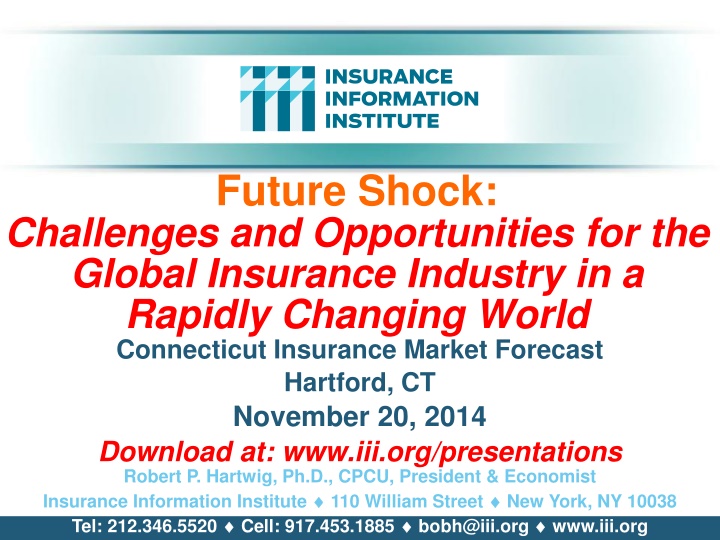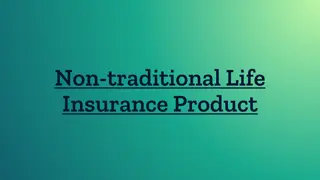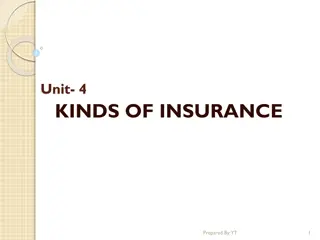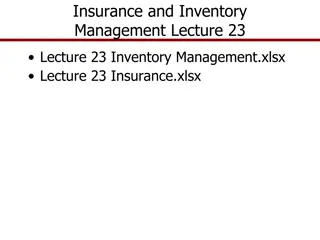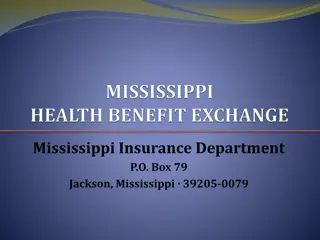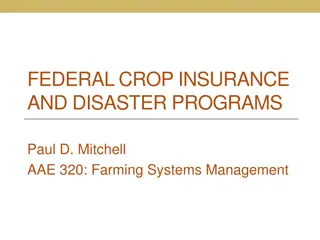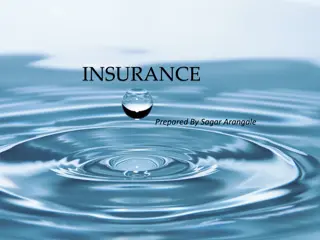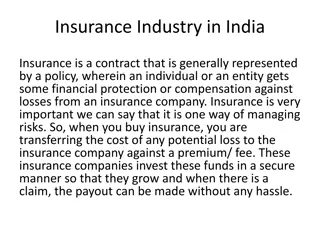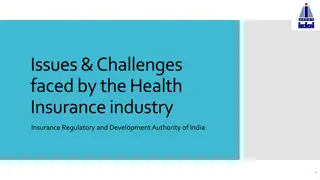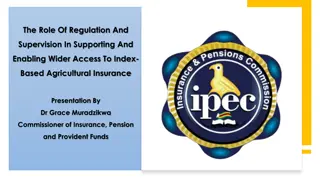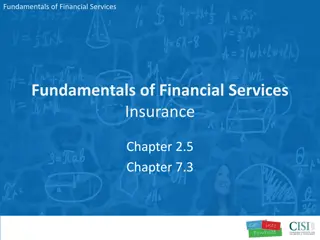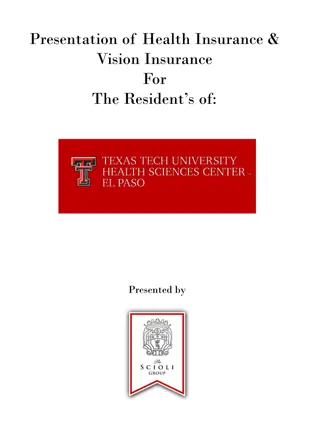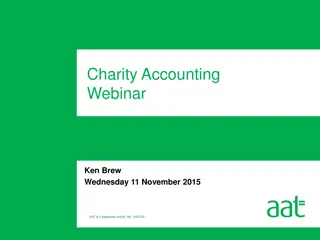Challenges and Opportunities in Global Insurance Industry
This content provides insights into the dynamic landscape of the global insurance industry, highlighting key trends, market forecasts, and the evolving role of insurance in the economy. Explore the distribution of global insurance premiums, growth patterns in emerging markets, and the top 15 insurance markets in 2013.
Download Presentation

Please find below an Image/Link to download the presentation.
The content on the website is provided AS IS for your information and personal use only. It may not be sold, licensed, or shared on other websites without obtaining consent from the author.If you encounter any issues during the download, it is possible that the publisher has removed the file from their server.
You are allowed to download the files provided on this website for personal or commercial use, subject to the condition that they are used lawfully. All files are the property of their respective owners.
The content on the website is provided AS IS for your information and personal use only. It may not be sold, licensed, or shared on other websites without obtaining consent from the author.
E N D
Presentation Transcript
Future Shock: Challenges and Opportunities for the Global Insurance Industry in a Rapidly Changing World Connecticut Insurance Market Forecast Hartford, CT November 20, 2014 Download at: www.iii.org/presentations Robert P. Hartwig, Ph.D., CPCU, President & Economist Insurance Information Institute 110 William Street New York, NY 10038 Tel: 212.346.5520 Cell: 917.453.1885 bobh@iii.org www.iii.org
Presentation Outline Insurance: A Global Force The Impact of the Insurance Economy Dollars and Jobs Public Perceptions of the Insurance Industry The Importance of Insurance: P/C Life Health The Insurance Equation: Challenge = Opportunity Old & New: Challenges and Insurance Solutions An Industry Built of Strength & Experience Q&A 2
INSURANCE: We Are a Global Force Becoming More Global Is the Destiny of the Insurance Industry 3 3
Distribution of Global Insurance Premiums, 2013 ($ Trillions) Total Premium Volume = $4.641 Trillion* Non-Life, $2.03 , 43.8% Life insurance accounted for 56.2% of global premium volume in 2013 vs. 43.8% for Non-Life Life, $2.61 , 56.2% Source: Swiss Re, sigma, No. 3/2014; Insurance Information Institute. 4
Distribution of Nonlife Premium: Industrialized vs. Emerging Markets, 2013 2013, $Billions Premium Growth Facts Industrialized Economies Emerging market s share of nonlife premiums increased to 19.5% in 2013, up from 17.3% in 2012 and 14.3% in 2009. The share of premiums written in the $2 trillion global nonlife market remains much larger (80.5%) but continues to shrink. $1, 653.0 19.5% Emerging Markets $399.8 80.5% The financial crisis and sluggish recovery in the major insurance markets will accelerate the expansion of the emerging market sector Developing markets now account for about 40% of global GDP but just under 20% of nonlife premiums Sources: Swiss Re sigma No.4/2013; Insurance Information Institute research. 5
Tope 15 Insurance Markets in 2013, Life and Property/Casualty Global premium volume in 2013 = $4.641 Trillion $ Billions $1,400 $1,259.3 Countries in all parts of the world except Africa are now represented among the world s largest insurance markets $1,200 $1,000 $800 $531.5 $600 $329.6$278.0 $400 $254.8 $247.2 $168.6 $145.4$125.3$101.1 $90.0 $88.9 $78.3 $72.5 $65.6 $200 $0 UK US Japan Spain India Italy China Canada Netherlands Australia Brazil Taiwan France S. Korea Germany Source: Swiss Re, sigma, No. 3/2014; Insurance Information Institute.
Premium Growth by Region, 2013 Growth in Advanced Asia (incl. China) markets decelerated in 2013 Latin America growth was the strongest in 2013 12.2% 13.4% 12.8% 10.2% 15% 9.4% 9.0% 7.5% 7.1% 7.2% 10% 5.6% 5.1% 4.0% 4.1% 2.6% 2.2% 2.6% 2.3% 2.1% 1.9% 1.4% 1.7% 1.7% 5% 0.8% 0.3% -0.1% 0.7% 0% -0.3% -2.0% -5% -3.2% Strength in Africa, -6.9% -10% World N. Latin America W. Central & E. Europe Advanced Asia Emerging Asia Middle East & Central Asia Africa Oceania America Europe Life Non-Life Total Global Premium Volume Totaled $4.641 Trillion in 2013, up 1.4% from $4.599 Trillion in 2012. Global Growth Was Weighed Down by Slow Growth in N. America and W. Europe and Partially Offset by Emerging Markets Source: Swiss Re, sigma, No. 3/2013. 7
Non-Life Insurance: Global Real (Inflation Adjusted) Premium Growth, 2013 Real growth in non- life insurance premiums was faster in China and most of SE Asia than the US Growth in Emerging markets is much faster than in Advanced markets Market Advanced Emerging World Life -0.2 6.4 0.7 Non-Life 1.1 8.3 2.3 Total 0.3 7.4 1.4 Source: Swiss Re, sigma, No. 3/2014. 8
Global Real (Inflation Adjusted) Premium Growth: 1980-2013 Premium growth is very erratic in part to inflation volatility in emerging markets as well as a lack of consistent cyclicality Emerging market growth has exceeded that of industrialized countries in 30 of the past 34 years, including the entirety of the global financial crisis and subsequent recovery Source: Swiss Re, sigma, No. 3/2014. 9
GDP Growth: Advanced & Emerging Economies vs. World, 1970-2015F Emerging economy growth rates are expected to ease to 4.4% in 2014 and 5.0% in 2015 GDP Growth (%) World output is forecast to grow by 3.3% in 2014 and 3.8% in 2015. The world economy shrank by 0.6% in 2009 amid the global financial crisis 10.0 8.0 6.0 4.0 2.0 0.0 Advanced economies are expected to grow at a modest pace of 1.8% in 2014 and to 2.3% in 2015. (2.0) (4.0) 70 71 72 73 74 75 76 77 78 79 80 81 82 83 84 85 86 87 88 89 90 91 92 93 94 95 96 97 98 99 00 01 02 03 04 05 06 07 08 09 10 11 12 13 14F 15F Advanced economies Emerging and developing economies World Source: International Monetary Fund, World Economic Outlook , October 2014; Insurance Information Institute.
Real GDP Growth Forecasts: Major Economies: 2011 2015F US growth should accelerate in 2015 Growth in China has slowed but outpaces the US and Europe 9.3% 10% 7.7% 7.7% 7.4% 7.1% 8% The Eurozone remains weak 6% 4.6% 3.2% 3.1% 2.9% 2.7% 2.6% 4% 2.6% 2.4% 2.3% 2.2% 2.2% 2.2% 2.3% 2.0% 1.8% 1.7% 1.6% 1.5% 1.3% 1.3% 0.8% 0.9% 2% 0.3% 0% Political turmoil in Latin America is hurting growth -0.5% -0.7% -2% US Euro Area UK Latin America Canada China 2011 2012 2013F 2014F 2015F Growth Prospects Vary Widely by Region but the Outlook for 2015 Has Dimmed Except in the US and UK Sources: Blue Chip Economic Indicators (10/2014 issue); IMF (10/2014); Insurance Information Institute. 11
Gap Between Economic and Insured Losses: 1980 2013 The gap between economic and insured losses is growing suggesting both a problem and an opportunity Sources: Guy Carpenter, Swiss Re; Insurance Information Institute . 13 13
Globalization: The Global Economy Creates Opportunities & Risks Globalization Is a Double Edged Sword Creating Opportunity and Wealth But Potentially Creating and Amplifying Risk Greater Reward Greater Risk 14 14
5 Major Categories for External Global Risks, Uncertainties and Fears: Insurance Solutions 1. Economic Risks 2. Geopolitical Risks 3. Environmental Risks 4. Technological Risks 5. Societal Risks While risks can be broadly categorized, none are mutually exclusive Source: Adapted from World Economic Forum, Global Risks 2014; Insurance Information Institute. 15
Multitude of Exogenous Factors Influence Insurer Growth, Performance & Cyclicality Economic Issues in US, Europe Weakness in China/Emerging Economies Political Upheaval in the Ukraine, Middle East Syria, Iraq, Thailand, Argentina, Venezuela Trade sanctions (e.g., Iran, Russia) Political Gridlock in the US, Europe, Japan Fiscal/Monetary Imbalances/Low Interest Rates Unemployment Resurgent Terrorism Risk: ISIS & Other Groups Cyber Attacks (theft, espionage, terrorism) Ebola Crisis Sabre Rattling (e.g., US-China, Russia-Ukraine) Separatist Fever (UK/Scotland, Spain) Severe Natural Disaster Losses Climate Change/Sea Level Rise Environmental Degradation (Over)Regulation: Systemic Risk? Are Black Swans everywhere or does it just seem that way? 16
The Economics of Connecticut s Insurance Industry Insurance Remains Key to Connecticut s Economy 17 17
US Insurance and Related Activities as a Percent of US GDP, 1997-2012 3.0% Insurance activity accounts for about 2.5% of US GDP annually 2.8% 2.73% 2.70% 2.62%2.64%2.64% 2.63% 2.56% 2.6% 2.53% 2.50% 2.49% 2.45% 2.45% 2.45%2.45% 2.4% 2.31% 2.32% 2.2% 2.0% 97 98 99 00 01 02 03 04 05 06 07 08 09 10 11 12 Recessions and investment reverses (in 2001 and 2008) cut into the contribution of the Insurance Industry to U.S. GDP. In times of healthier economic growth, the industry contributes between 2.5% and 2.75% of U.S. GDP Sources: U.S. Department of Commerce, Bureau of Economic Analysis; Insurance Information Institute. 18
Insurance and Related Activities in CT as a Percent of CT GDP, 1997-2012 12.0% 10.66% 9.49% 8.94% 8.74% 8.91% 8.53% 8.34% 8.26% 8.30% 7.59%7.76% 7.74%7.41% 7.58% 8.0% 7.01% 6.61% Insurance activity accounts for 7% - 8% of Connecticut s economy, three times that of the US overall 4.0% 0.0% 97 98 99 00 01 02 03 04 05 06 07 08 09 10 11 12 Recessions and investment reverses (in 2001 and 2008) cut into the contribution of the Insurance Industry to CT GDP. In times of healthier economic growth, the industry contributes between 7% and 9% (and sometimes more) of Connecticut s state GDP Sources: U.S. Department of Commerce, Bureau of Economic Analysis; Insurance Information Institute. 19
Insurance and Related Activities as a Percent of GDP, US vs. CT, 1997-2012 Insurance activity in CT is three times that of the US overall CT US 10.66% 12.0% 9.49% 8.94% 8.91% 8.74% 8.53% 8.34% 8.26% 8.30% 7.76% 7.74% 7.59% 7.58% 7.41% 7.01% 6.61% 8.0% 2.73% 2.70% 4.0% 2.63% 2.62% 2.64% 2.64% 2.56% 2.53% 2.50% 2.49% 2.45% 2.45% 2.45% 2.45% 2.31% 2.32% 0.0% 97 98 99 00 01 02 03 04 05 06 07 08 09 10 11 12 Recessions and investment reverses (in 2001 and 2008) cut into the contribution of the Insurance Industry to GDP. In times of healthier economic growth, the industry contributes between 7% and 9% (and sometimes more) of Connecticut s state GDP Sources: U.S. Department of Commerce, Bureau of Economic Analysis; Insurance Information Institute. 20
INSURANCE INDUSTRY EMPLOYMENT TRENDS A Big, Important Industry With Many Employment Crosscurrents 21 21
Insurance Industry Employment* 2000-2014F Insurance industry employment is recovering and will likely reach a new record level of employment in early 2015 Annual Average, in Thousands Insurance industry employment added nearly 185,000 jobs from 2000 to 2008, an increase 8.3% 2,405.1 2,400.0 2,391.6 2,379.1 2,379.4 2,450 2,370.6 2,367.5 2,368.3 2,340.6 2,338.9 2,336.4 2,400 2,350 2,266.0 2,233.7 2,233.2 2,300 2,220.6 2,250 Insurance industry employment fell by 2.9% during Great Recession 2,200 2,150 2,100 00 01 02 03 04 05 06 07 08 09 10 11 12 13 14F *Includes direct writers, claims adjusters, third-party administrators of insurance funds and other service personnel such as advisory and insurance ratemaking services. Sources: U.S. Department of Labor, Bureau of Labor Statistics; Insurance Information Institute (2014 forecast). 22
Overview of Insurance Sector Employment Changes* August 2014 Employment September 2014 Employment Insurance Subsector Change CARRIERS 534,300 341,900 496,200 73,500 27,400 535,000 343,500 498,300 73,100 27,400 +700 +1,600 +2,100 -400 P-C Direct Life Direct Health/Medical Direct Title & Other Direct Reinsurers OTHERS Agents/Brokers 3rd-Party Administration Claims Adjusters 0 689,800 164,500 50,600 692,000 166,500 50,000 +2,200 +2,000 -600 *Data are through September 2014 and are preliminary (i.e., subject to later revision); seasonally adjusted. 23
Insurance Industry Employment Trends Over the Past 25 Years, Each Industry Segment Has Had Different Employment Experiences 24
U.S. Employment in the Direct P/C Insurance Industry: 1990 2014* Thousands P/C 560 employment is recovering The BLS occasionally reclassifies employment within industries. When this happens, the change is spread evenly over a 12-month period (in this case March 2010-March 2011. 540 520 500 480 460 '90 '91 '92 '93 '94 '95 '96 '97 '98 '99 '00 '01 '02 '03 '04 '05 '06 '07 '08 '09 '10 '11 '12 '13 '14 *As of September 2014; not seasonally adjusted; Does not including agents & brokers. Note: Recessions indicated by gray shaded columns. Sources: U.S. Bureau of Labor Statistics; National Bureau of Economic Research (recession dates); Insurance Information Institute. 25
U.S. Employment in the Direct Life Insurance Industry: 1990 2014* Thousands 600 575 550 525 500 475 Life 450 employment is basically flat 425 Every 4-5 years BLS reconciles its data with census data; sometimes this reclassifies employment within industries. This drop, spread over March 2004-March 2005, moved some people to the Health/Medical Expense sector. 400 375 350 325 300 '90 '91 '92 '93 '94 '95 '96 '97 '98 '99 '00 '01 '02 '03 '04 '05 '06 '07 '08 '09 '10 '11 '12 '13 '14 *As of September 2014; not seasonally adjusted; Does not including agents & brokers. Note: Recessions indicated by gray shaded columns. Sources: U.S. Bureau of Labor Statistics; National Bureau of Economic Research (recession dates); Insurance Information Institute. 26
U.S. Employment in the Direct Health- Medical Insurance Industry: 1990 2014* Thousands 500 475 450 425 400 375 350 325 300 Employment in the Health- Medical insurance segment is seeing strong growth, as it has for most of the past 25 years. 275 250 225 200 175 '90 '91 '92 '93 '94 '95 '96 '97 '98 '99 '00 '01 '02 '03 '04 '05 '06 '07 '08 '09 '10 '11 '12 '13 '14 *As of September 2014; not seasonally adjusted; Does not including agents & brokers. Note: Recessions indicated by gray shaded columns. Sources: U.S. Bureau of Labor Statistics; National Bureau of Economic Research (recession dates); Insurance Information Institute. 27
U.S. Employment in the Reinsurance Industry: 1990 2014* Thousands 48 44 40 After a multi-decade decline, Reinsurance employment has shown some recent growth 36 32 28 24 '90 '91 '92 '93 '94 '95 '96 '97 '98 '99 '00 '01 '02 '03 '04 '05 '06 '07 '08 '09 '10 '11 '12 '13 '14 *As of September 2014; not seasonally adjusted; Does not including agents & brokers. Note: Recessions indicated by gray shaded columns. Sources: U.S. Bureau of Labor Statistics; National Bureau of Economic Research (recession dates); Insurance Information Institute. 28
U.S. Employment in Insurance Agencies & Brokerages: 1990 2014* Thousands 700 675 650 625 Agency/Brokerage employment is recovering despite consolidation 600 575 550 525 500 '90 '91 '92 '93 '94 '95 '96 '97 '98 '99 '00 '01 '02 '03 '04 '05 '06 '07 '08 '09 '10 '11 '12 '13 '14 *As of September 2014; not seasonally adjusted. Includes all types of insurance. Note: Recessions indicated by gray shaded columns. Sources: U.S. Bureau of Labor Statistics; National Bureau of Economic Research (recession dates); Insurance Information Institute. 29
U.S. Employment in Insurance Claims Adjusting: 1990 2014* Thousands Claims adjusting is a profession in transition 60 55 50 45 40 '90 '91 '92 '93 '94 '95 '96 '97 '98 '99 '00 '01 '02 '03 '04 '05 '06 '07 '08 '09 '10 '11 '12 '13 '14 *As of September 2014; not seasonally adjusted. Note: Recessions indicated by gray shaded columns. Sources: U.S. Bureau of Labor Statistics; National Bureau of Economic Research (recession dates); Insurance Information Institute. 30
U.S. Employment in Third-Party Administration of Insurance Funds: 1990 2014* Thousands 170 160 150 140 More work is being done by TPAs 130 120 110 100 90 '90 '91 '92 '93 '94 '95 '96 '97 '98 '99 '00 '01 '02 '03 '04 '05 '06 '07 '08 '09 '10 '11 '12 '13 '14 *As of September 2014; not seasonally adjusted. Includes all types of insurance. Note: Recessions indicated by gray shaded columns. Sources: U.S. Bureau of Labor Statistics; National Bureau of Economic Research (recession dates); Insurance Information Institute. 31
How Does the Public (and Prospective Employees) View the Industry? I.I.I. Survey: Insurance Favorability Ratings Are Fairly Strong 32
I.I.I. Poll: Favorability Percent of Public Rating Industry as Very or Mostly Favorable, 2014 Auto/Home Favorability outranks other key industries 70% 65% 62% 60% 59% 60% 53% 50% 50% 44% 36% 40% 35% 33% 30% 20% 10% Auto insurance Home insurance Banking Life insurance Health insurance Electric utility companies Mutual fundsPharmaceutical Financial services companies Oil and gas companies companies Source: Insurance Information Institute Annual Pulse Survey. 34
I.I.I. Poll: Favorability Percent of Public Rating Industry as Very or Mostly Favorable, 1968-2014 Auto/Home Favorability Has Outranked Banking Four Years in a Row. 90% 80% 70% 60% 50% 40% Auto and home insurance Banking Mutual funds 30% 20% 10% Auto/Home Insurers Continue to Rank Higher Than Banking, Mutual Funds. Source: Insurance Information Institute Annual Pulse Survey. 35
Insurance Market Overview: A Segmented Industry Property/Casualty Life/Annuity Health 36 36
Property/Casualty Insurance Industry Trends Rich History, Poised to Manage the Risks and Seize the Opportunities of the Future 37 37
Cumulative Value of Inflation-Adjusted Claims Paid by P/C Insurers, 1925 2010E* Adjusted for inflation, it took 36 years for the industry to pay its first $1 trillion in claims in the years since 1925. Today, the industry pays $1 trillion in claims every 2 to 3 years after adjusting for inflation. $ Billions $14,000 $13,000 3 years (2008) $12,000 3 years (2005) $11,000 2 years (2002) $10,000 4 years (2000) $9,000 3 years (1996) $8,000 3 years (1993) $7,000 4 years (1990) $6,000 4 years (1986) $5,000 5 years (1982) $4,000 7 years (1977) $3,000 9 years (1970) $2,000 36 years (1925 1961) $1,000 $0 2010E 1925 1930 1935 1940 1945 1950 1955 1960 1965 1970 1975 1980 1985 1990 1995 *2000 *2005 *1925 1934 stock companies only. Includes workers compensation state funds 1998-2006. Sources: Insurance Information Institute research and calculations from A.M. Best data. 38
P/C Industry Net Income After Taxes 1991 2014:H1 2005 ROE*= 9.6% 2006 ROE = 12.7% 2007 ROE = 10.9% 2008 ROE = 0.1% 2009 ROE = 5.0% 2010 ROE = 6.6% 2011 ROAS1 = 3.5% 2012 ROAS1 = 5.9% 2013 ROAS1 = 10.3% 2014 ROAS1 = 7.8% Net income rose strongly (+81.9%) in 2013 vs. 2012 on lower cats, capital gains $ Millions $65,777 $80,000 $63,784 $62,496 $70,000 $60,000 $44,155 $38,501 $36,819 $50,000 $35,204 $33,522 $30,773 $30,029 $28,672 $25,980 $40,000 $24,404 $21,865 $20,598 $20,559 $19,456 $19,316 $30,000 $14,178 $10,870 $20,000 $5,840 $3,046 $3,043 2014 is off to a slower start $10,000 $0 -$6,970 -$10,000 14:H1 91 92 93 94 95 96 97 98 99 00 01 02 03 04 05 06 07 08 09 10 11 12 13 ROE figures are GAAP; 1Return on avg. surplus. Excluding Mortgage & Financial Guaranty insurers yields a 7.7% ROAS through 2014:Q2, 9.8% ROAS in 2013, 6.2% ROAS in 2012, 4.7% ROAS for 2011, 7.6% for 2010 and 7.4% for 2009. Sources: A.M. Best, ISO; Insurance Information Institute
Profitability Peaks & Troughs in the P/C Insurance Industry, 1975 2014:H1* ROE History suggests next ROE peak will be in 2016-2017 1977:19.0% 1987:17.3% 25% 20% 2006:12.7% 1997:11.6% 2013 10.4% 15% 9 Years 10% 5% 2014:H1 7.7% 0% 2001: -1.2% 1975: 2.4% 1984: 1.8% 1992: 4.5% -5% 75 76 77 78 79 80 81 82 83 84 85 86 87 88 89 90 91 92 93 94 95 96 97 98 99 00 01 02 03 04 05 06 07 08 09 10 11 12 13 14 *Profitability = P/C insurer ROEs. 2011-14 figures are estimates based on ROAS data. Note: Data for 2008-2014 exclude mortgage and financial guaranty insurers. Source: Insurance Information Institute; NAIC, ISO, A.M. Best.
Back to the Future: Profitability Peaks & Troughs in the P/C Insurance Industry, 1950 2014* 1970-90: Peak ROEs were much higher in this period while troughs were comparable. High interest rates, rapid inflation, economic volatility all played roles ROE 1990-2010s: D j vu. Excluding mega- CATs, this period is very similar to the 1950-1970 period 1950-70: ROEs were lower in this period. Low interest rates, low inflation, Bureau rate regulation all played a role 25% 1977:19.0% 20% 1987:17.3% 2006:12.7% 1972:13.7% 1997:11.6% 15% 2013 10.4% 1950:8.0% 1966-67: 5.5% 10% 1959:6.8% 5% 2014:H1 7.7% 1969: 3.9% 0% 1992: 4.5% 1984: 1.8% 1975: 2.4% 1965: 2.2% 1957: 1.8% 2001: -1.2% -5% 50 52 54 56 58 60 62 64 66 68 70 72 74 76 78 80 82 84 86 88 90 92 94 96 98 00 02 04 06 08 10 12 14:H1 *Profitability = P/C insurer ROEs. 2011-14 figures are estimates based on ROAS data. Note: Data for 2008-2014 exclude mortgage and financial guaranty insurers. 2014 figure is through Q2. Source: Insurance Information Institute; NAIC, ISO, A.M. Best.
ROE: Property/Casualty Insurance by Major Event, 1987 2014:H1 (Percent) P/C Profitability Is Both by Cyclicality and Ordinary Volatility 20% Katrina, Rita, Wilma Low CATs 15% 10% Sept. 11 5% Hugo Lowest CAT Losses in 15 Years 4 Hurricanes Sandy Andrew 0% Record Tornado Losses Northridge Financial Crisis* -5% 87 88 89 90 91 92 93 94 95 96 97 98 99 00 01 02 03 04 05 06 07 08 09 10 11 12 13 14* * Excludes Mortgage & Financial Guarantee in 2008 2014. 2014 figure is through H1:2014. Sources: ISO, Fortune; Insurance Information Institute. 42
Policyholder Surplus, 2006:Q4 2014:H1 ($ Billions) $700 Drop due to near-record 2011 CAT losses 2007:Q3 Pre-Crisis Peak $671.6 $662.0 $653.3 $624.4 $650 $614.0 $607.7 $586.9 $583.5 $566.5 $600 $570.7 $567.8 $559.2 $559.1 $550.3 $544.8 $540.7 $538.6 $530.5 $550 $521.8 $517.9 $515.6 $512.8 $511.5 $505.0 $496.6 $490.8 $487.1 $478.5 $500 $463.0 $455.6 Surplus as of 6/30/14 stood at a record high $671.6B $437.1 $450 $400 06:Q4 07:Q1 07:Q2 07:Q3 07:Q4 08:Q1 08:Q2 08:Q3 08:Q4 09:Q1 09:Q2 09:Q3 09:Q4 10:Q1 10:Q2 10:Q3 10:Q4 11:Q1 11:Q2 11:Q3 11:Q4 12:Q1 12:Q2 12:Q3 12:Q4 13:Q1 13:Q2 13:Q3 13:Q4 14:Q1 14:Q2 The industry now has $1 of surplus for every $0.73 of NPW, close to the strongest claims-paying status in its history. 2010:Q1 data includes $22.5B of paid-in capital from a holding company parent for one insurer s investment in a non-insurance business . The P/C insurance industry entered 2014 in very strong financial condition. Sources: ISO, A.M .Best. 43
P/C Net Premium Growth: Annual Change, 1971 2014F (Percent) 1975-78 1984-87 2000-03 25% Net Written Premiums Fell 0.7% in 2007 (First Decline Since 1943) by 2.0% in 2008, and 4.2% in 2009, the First 3- Year Decline Since 1930-33. 20% 2014F: 4.0% 2013: 4.6% 2012: +4.3% 15% 10% 5% 0% -5% 71 72 73 74 75 76 77 78 79 80 81 82 83 84 85 86 87 88 89 90 91 92 93 94 95 96 97 98 99 00 01 02 03 04 05 06 07 08 09 10 11 12 13 14 Shaded areas denote hard market periods Sources: A.M. Best (historical and forecast), ISO, Insurance Information Institute. 45
Direct Premiums Written: Total P/C Percent Change by State, 2007-2013 Top 25 States 80 74.6 North Dakota was the country s growth leader over the past 6 years with premiums written expanding by 74.6% 70 60 Pecent change (%) 50 36.9 40 31.9 27.4 25.2 24.9 30 22.5 22.2 16.6 15.9 15.7 20 14.5 14.5 14.3 12.6 11.9 11.8 11.2 10.5 10.3 9.9 9.8 9.3 9.1 9.0 8.6 10 0 VA AL AR AK LA IA WI WY NJ VT MI NE KS KY ND SD OK OH SC MN IN CO MO NM TX TN Sources: SNL Financial LC.; Insurance Information Institute. 46
Direct Premiums Written: Total P/C Percent Change by State, 2007-2013 Bottom 25 States 10 8.5 8.2 7.9 7.8 7.6 7.3 7.0 6.9 6.2 5.9 5.6 5.3 4.2 4.1 5 3.5 1.6 1.0 0.4 Pecent change (%) 0 -0.7 -1.7 -1.9 -5 -4.1 -5.7 -6.7 Growth was negative in 7 states and DC between 2007 and 2013 -10 -12.6 -15 -15.3 -20 AZ WA WV GA MA PA CA NV RI FL HI IL US NY DE MS ME NC NH DC MD ID OR CT UT MT Sources: SNL Financial LC.; Insurance Information Institute. 47
Life Insurance Trends Critical Sector, Key Products What Don t Millennials Understand? 48 48
Amount of Life Insurance Death Benefits Paid, 2005-2013 Millions $116.6 $120 $112.3 $104.3 $100.9 $95.3 $100 $89.0 $83.7 $79.3 $75.9 $80 $60 $40 $20 $0 2005 2006 2007 2008 2009 2010 2011 2012 2013 The amount of death benefits life insurers paid grew by 53.6% in the 8 years since 2005 (averaging 5.5% growth per year). Sources: NAIC, via SNL Financial; Insurance Information Institute. 49
Amount of Individual Life Insurance (Death Benefits) Issued, by Type of Policy, 2005-2013 Billions Term Insurance Permanent Insurance The Great Recession negatively impacted life insurance sales $1.75 $1.35 $1.34 $1.50 $1.27 $1.27 $1.26 $1.12 $1.09 $1.09 $1.25 $1.05 $1.00 $0.75 $0.56 $0.56 $0.55 $0.51 $0.52 $0.52 $0.51 $0.49 $0.44 $0.50 $0.25 $0.00 2005 2006 2007 2008 2009 2010 2011 2012 2013 The amount of term life insurance (measured by death benefit amounts) issued yearly has slipped since 2008, from $1.35 billion to $1.05 billion, while the amount of permanent life insurance grew slightly. Sources: NAIC, via SNL Financial; Insurance Information Institute. 50
Group Insurance Premiums (line) Track Nonfarm Employment (bars) Nonfarm employment* Group Ins Premiums The spike is mainly in Group Annuity premiums; it represents de-risking by a few giant DB plans Group Premiums 140 $300 $275 Nonfarm Employment (millions) 135 $250 $225 137.6 136.9 136.4 136.1 130 $200 133.7 133.7 131.9 131.5 131.5 130.9 130.5 130.1 129.9 $175 125 $150 2001 2002 2003 2004 2005 2006 2007 2008 2009 2010 2011 2012 2013 *Not seasonally adjusted. Group premiums = group life, group annuities, and group a&h Sources: Bureau of Labor Statistics; NAIC Annual Statements, via SNL Financial; http://www.bls.gov/ces/; I.I.I.
Healthcare Cost Trends Healthcare Cost Will Move Up for the Indefinite Future Health Insurers Will Grow and Adapt 55 55
U.S. Health Care Expenditures, 1965 2022F $ Billions From 1965 through 2013, US health care expenditures had increased by 69 fold. Population growth over the same period increased by a factor of just 1.6. By 2022, health spending will have increased 119 fold. $6,000 $5,008.8 $4,702.0 $4,416.2 $5,000 $4,142.4 $3,889.1 $3,660.4 $3,458.3 $3,273.4 $4,000 $3,093.2 $2,914.7 $2,806.6 $2,700.7 $2,600.0 $2,501.2 $2,406.6 $2,298.3 $2,163.3 $3,000 $2,030.5 $1,901.6 $1,775.4 $1,638.0 $1,493.3 $1,377.2 $1,286.5 $1,208.9 $2,000 $1,142.6 $1,081.8 $1,027.4 $972.7 $921.5 $857.9 $791.5 $724.3 $647.5 $581.7 $519.1 $476.9 $444.6 $406.5 $369.0 $1,000 $334.7 $296.7 $255.8 $221.7 $195.5 $174.0 $153.0 $133.6 $117.2 $103.4 $93.1 $83.2 $74.9 $66.2 $58.8 $51.8 $46.3 $42.0 $0 83 90 22 65 U.S. health care expenditures have been on a relentless climb for most of the past half century, far outstripping population growth, inflation of GDP growth Sources: Centers for Medicare & Medicaid Services, Office of the Actuary at http://www.cms.gov/Research-Statistics-Data-and-Systems/Statistics- Trends-and-Reports/NationalHealthExpendData/NationalHealthAccountsProjected.html accessed 3/14/14; Insurance Information Institute. 66 67 68 69 70 71 72 73 74 75 76 77 78 79 80 81 82 84 85 86 87 88 89 91 92 93 94 95 96 97 98 99 00 01 02 03 04 05 06 07 08 09 10 11 12 13 14 15 16 17 18 19 20 21 56
